Pesticide usage in Scotland 2016: soft fruit crops
A revised version of this report has been issued to correct inaccuracies in active substance application weight data that were overestimated in the original report. This issue only affects certain herbicide active substances in relation to quantity applied. Please do not use the original version of this report as this has now been replaced by the revised 2020 report: Pesticide usage in Scotland 2016: soft fruit crops – revised 2020.
This publication presents information from a survey of pesticide use on soft fruit crops grown in Scotland during 2016.
This document is part of a collection
2016 Pesticide usage
All strawberries (protected and non-protected crops)
- An estimated 995 hectares of strawberries were grown in 2016. This consists of 75 ha of non-protected crops and 920 ha of protected crop
- Pesticides were applied to 18,222 treated hectares. Fungicides and insecticides were the most commonly applied pesticides ( Figure 11)
- 96 per cent of the crop was treated with a pesticide
- 7,869 kilograms of pesticide were applied to the crop
- Strawberry crops received on average 11.3 pesticide sprays ( Table 1). These sprays included 7.2 fungicide and three insecticide/acaricide applications (applied to 94 and 92 per cent of the crop area). They also received on average 2.2 herbicide, 2.7 biological, 1.9 sulphur and 1.3 molluscicide applications (applied to 52, 43, 18 and 20 per cent respectively)
- In relation to timings of pesticide applications, fungicides and insecticides/acaricides were applied between February and October, 60 per cent of sulphur was applied in July and herbicides were applied throughout the year with a third applied in February ( Figure 12)
- The most common variety encountered was Sonata, accounting for 84 per cent of the sample area
- 13 per cent of strawberries encountered in the sample were under one year old, 39 per cent were between one and two years old and 48 percent were over two years old
- 52 per cent of the crop sampled was grown directly in the soil, with the remainder being grown in bags or troughs. 44 per cent of the crop sampled was grown on a table top system
- 43 per cent of the crop sampled was grown with a ground mulch or straw
- 95 per cent of the crop sampled was grown under protection, of this 73 per cent were in temporary tunnels and 27 per cent were in permanent tunnels
- Pollinators were used on 78 per cent of the strawberry crop sampled; six per cent had no pollinators with the remainder unknown. On the sampled area using pollinators 87 per cent were bumble bees and 11 per cent were bumble and honey bees
- 99 per cent of the strawberry crops surveyed were harvested in 2016. 93 per cent were for fresh market, six per cent for pick-your-own and one per cent for processing
- Reasons for use on strawberry crops are presented in Figures 13 to 15. Ninety eight per cent of the use of herbicides was for general weed control with the remainder specified for couch
Summary of pesticide use on all strawberries:
| Pesticide group | Formulation area treated (ha) | Weight of pesticides applied (kg) | % of crop area treated | Most used formulations (ha) |
|---|---|---|---|---|
| Fungicides | 10,593 | 5,682 | 94 | Myclobutanil (1,608) |
| Herbicides | 2,001 | 1,510 | 52 | Diquat (828) |
| Insecticides/acaricides | 3,858 | 322 | 92 | Lambda-cyhalothrin (886), Abamectin (858) |
| Molluscicides | 253 | 59 | 20 | Metaldehyde (194) |
| Sulphur | 339 | 185 | 18 | N/A |
| Biopesticides | 780 | 64 | Bacillus subtilis (767) | |
| Biological control agents | 374 | N/A | Steinernema kraussei (114), heterorhabditis bacteriophora (113) | |
| Physical control | 24 | 47 | 1 | Carbonic acid diamide/urea (24) |
N/A = not applicable
Figure 11: Use of pesticides on all strawberry crops (percentage of total area treated with formulations) - 2016
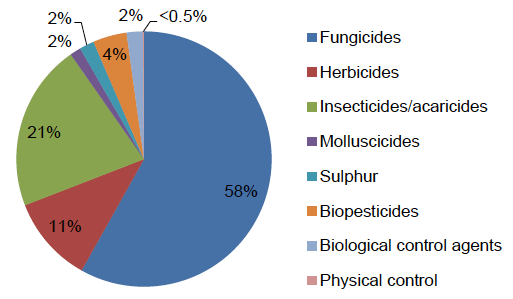
Figure 12: Timings of pesticide applications on all strawberries - 2016
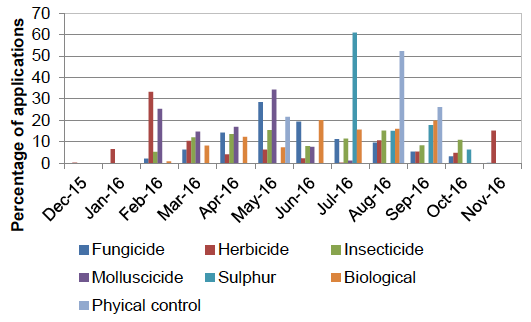
Note: Insecticides include acaricides. Biologicals includes biopesticides and biological control agents
Figure 13: Reasons for use of fungicides on all strawberry crops (where specified) - 2016
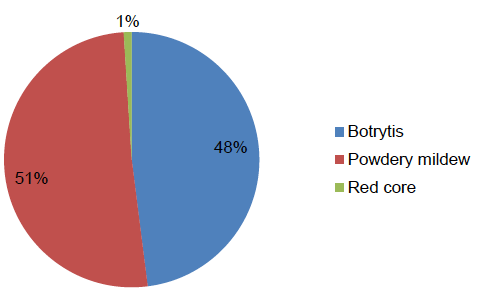
Figure 14: Reasons for use of insecticides and acaricides on all strawberry crops (where specified) – 2016

Figure 15: Reasons for use of biologicals on all strawberry crops (where specified) – 2016
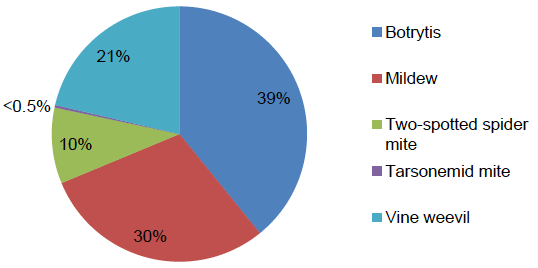
Note: biologicals include biopesticides and biological control agents
Non-protected strawberries
- An estimated 75 hectares of non-protected strawberry were grown in Scotland in 2016. This included an estimated two hectares recorded in the mixed and other soft fruit section of the census
- Pesticides were applied to 182 treated hectares. Fungicides and herbicides were the most commonly applied pesticides ( Figure 16)
- 41 per cent of the crop was treated with a pesticide
- 156 kilograms of pesticide were applied to the crop
- Symphony was the most common variety encountered, accounting for 56 per cent of the sample area
- Non-protected strawberry crops received on average 4.3 pesticide applications ( Table 1). These included 2.9 herbicide and 2.6 fungicide applications
- Fungicides were applied to non-protected strawberries between April and August. Herbicides applications were spread throughout the year with 42 per cent applied in March and insecticides were all applied in June ( Figure 17)
Summary of pesticide use on non-protected strawberries:
| Pesticide group | Formulation area treated (ha) | Weight of pesticides applied (kg) | % of crop area treated | Most used formulations (ha) |
|---|---|---|---|---|
| Fungicides | 109 | 72 | 38 | Fenhexamid (45) |
| Herbicides | 68 | 83 | 25 | Isoxaben (17), napropamide (17) |
| Insecticides/acaricides | 2 | <0.5 | 2 | Lambda-cyhalothrin (2) |
| Molluscicides | 3 | 1 | 2 | Ferric phosphate (3) |
Figure 16: Use of pesticides on non-protected strawberries (percentage of total area treated with formulations) - 2016
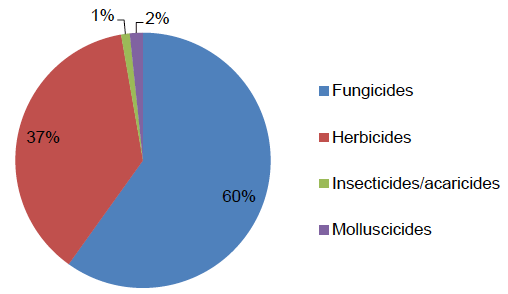
Figure 17: Timings of pesticide applications on non-protected strawberries - 2016
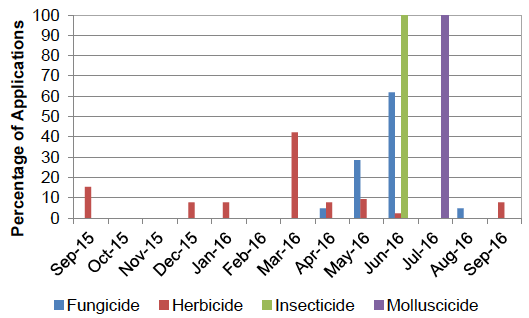
Protected strawberries
- An estimated 920 hectares of protected strawberry were grown in Scotland in 2016. Based on the ratio encountered in the sample, it is estimated that 71 per cent of the crop was semi-protected (grown under temporary tunnels) and 29 per cent permanently protected (grown in permanent tunnels or glasshouses)
- Pesticides were applied to 18,039 treated hectares. Fungicides and insecticides were the most commonly applied pesticides ( Figure 18)
- Over 99 per cent of the crop was treated with a pesticide
- 7,715 kilograms of pesticide were applied to the crop
- The most common variety encountered was Sonata, accounting for 87 per cent of the sample area
- Protected strawberry crops received on average 11.6 pesticide applications ( Table 1). These included 7.3 fungicide, 3.0 insecticide, 2.7 biological, 2.2 herbicide, 1.9 sulphur and 1.3 molluscicide applications
- In relation to timings of pesticide applications, fungicides and insecticides were applied between February and October. Herbicide use was spread throughout the year with 34 per cent applied in February ( Figure 19)
Summary of pesticide use on protected strawberries:
| Pesticide group | Formulation area treated (ha) | Weight of pesticides applied (kg) | % of crop area treated | Most used formulations (ha) |
|---|---|---|---|---|
| Fungicides | 10,483 | 5,611 | 99 | Myclobutanil (1,603) |
| Herbicides | 1,933 | 1,427 | 54 | Diquat (828) |
| Insecticides/acaricides | 3,856 | 322 | 99 | Lambda-cyhalothrin (884), abamectin (858) |
| Molluscicides | 250 | 59 | 21 | Metaldehyde (194) |
| Sulphur | 339 | 185 | 20 | N/A |
| Biopesticides | 780 | 64 | Bacillus subtilis (767) | |
| Biological control agents | 374 | N/A | Steinernema kraussei (114), Heterorhabditis bacteriophora (113) | |
| Physical control | 24 | 47 | 1 | Carbonic acid diamide/urea (24) |
N/A = not applicable
Figure 18: Use of pesticides on protected strawberries (percentage of total area treated with formulations) - 2016

Figure 19: Timings of pesticide applications on protected strawberries - 2016
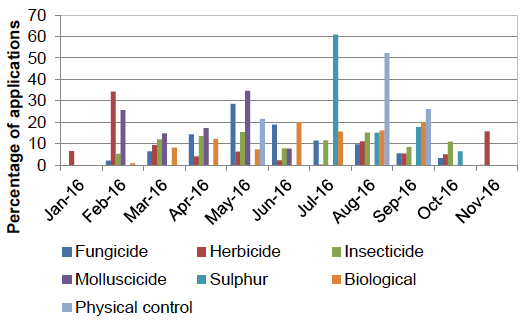
Note: Insecticides include acaricides. Biologicals includes biopesticides and biological control agents
All raspberries (protected and non-protected crops)
- An estimated 329 hectares of raspberries were grown in 2016. This consists of 131 ha of non-protected crops and 199 ha of protected crop
- Pesticides were applied to 2,596 treated hectares. Fungicides and herbicides were the most commonly applied pesticides
- 92 per cent of the crop received a pesticide treatment
- 1,723 kilograms of pesticide were applied to the crop
- Raspberry crops received on average 6.4 pesticide sprays ( Table 1). These sprays included 4.0 fungicide, 1.8 herbicide, 1.6 insecticide/acaricide and 1.5 biological applications
- 34 per cent of herbicides were applied in March, 36 per cent of insecticides in May, 48 per cent of fungicides in June and 68 per cent of biologicals were applied in July ( Figure 21)
- The most common variety encountered was Glen Ample accounting for 43 per cent of the sample area
- Six per cent of the raspberries encountered in the sample were under two years old, 81 per cent were between two and five years old and two per cent were over five years old with the remainder unknown
- 70 per cent of the crop sampled was grown directly in the soil, 25 per cent were grown in pots with the remainder unknown
- 15 per cent of the crop encountered was grown using a ground mulch
- 21 per cent of the raspberry crop sampled was grown outdoors, 57 per cent were in temporary tunnels and 22 per cent was grown under permanent tunnels
- Pollinators were used on 70 per cent of the raspberry crops surveyed, 20 per cent used no pollinators with the remainder unknown. Of the sampled area using pollinators 29 per cent were bumble bees, 19 per cent were honey bees and 52 per cent were bumble and honey bees
- 97 per cent of the raspberry crops surveyed were harvested in 2016. 83 per cent were for fresh market, 14 per cent for processing and three per cent for pick-your-own
- Reasons for use on raspberry crops are presented in Figures 22- 24. Eighty-eight per cent of the use of Biologicals was for the control of two spotted spider mite with the remainder specified for vine weevil
Summary of pesticide use on all raspberries:
| Pesticide group | Formulation area treated (ha) | Weight of pesticides applied (kg) | % of crop area treated | Most used formulations (ha) |
|---|---|---|---|---|
| Fungicides | 1,322 | 772 | 87 | Fenhexamid (351) |
| Herbicides | 719 | 638 | 72 | Diquat (201) |
| Insecticides/acaricides | 446 | 36 | 81 | Abamectin (152) |
| Molluscicides | <0.5 | <0.5 | <0.5 | Ferric phosphate (<0.5) |
| Sulphur | 34 | 270 | 10 | N/A |
| Biopesticides | 72 | 7 | Bacillus subtilis (64) | |
| Biological control agents | 3 | N/A | Phytoseiulus persimilis (3) |
N/A = not applicable
Figure 20: Use of pesticides on all raspberries (percentage of total area treated with formulations) - 2016
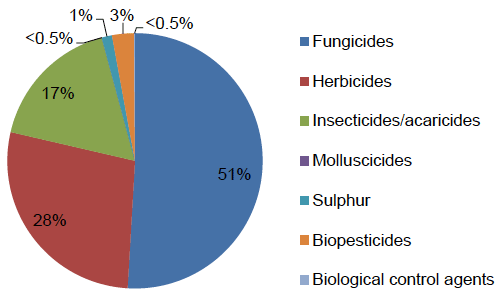
Figure 21: Timings of pesticide applications on all raspberries - 2016
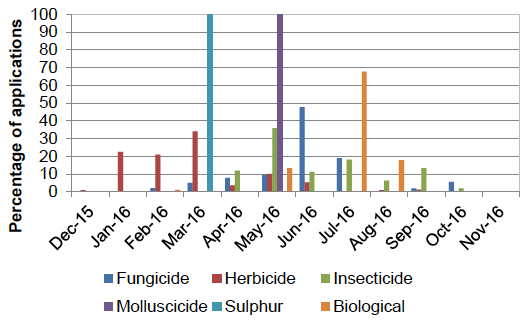
Note: Insecticides include acaricides. Biologicals includes biopesticides and biological control agents
Figure 22: Reasons for use of fungicides on all raspberry crops (where specified) – 2016
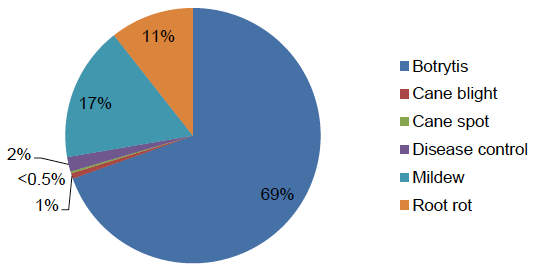
Figure 23: Reasons for use of herbicides on all raspberry crops (where specified) – 2016
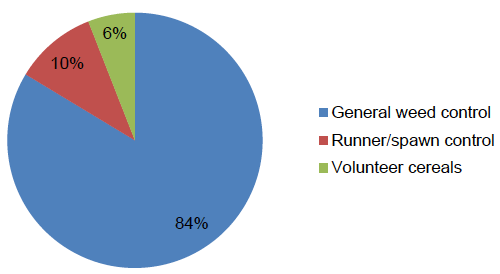
Figure 24: Reasons for use of insecticides/acaricides on all raspberry crops (where specified) – 2016
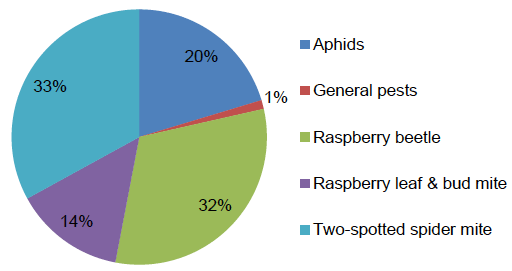
Non-protected raspberries
- An estimated 131 hectares of non-protected raspberries were grown in Scotland in 2016. This included an estimated three hectares recorded in the mixed and other crop category in the census
- Pesticides were applied to 1,032 treated hectares. Fungicides and herbicides were the most commonly applied pesticides ( Figure 25)
- 81 per cent of the crop was treated with a pesticide
- 846 kilograms of pesticide were applied to the crop
- Glen Ample and Glen Ericht were the most common varieties encountered, accounting for 30 and 23 per cent of the sample area respectively
- Non-protected raspberries received on average six applications of pesticides ( Table1). These sprays included 4.2 fungicide, 2.1 herbicide, 1.1 insecticide and 1.0 sulphur applications
- In relation to timings, 58 per cent of fungicides and 51 per cent of insecticide/acaricides were applied in June. 56 per cent of herbicides were applied in March ( Figure 26)
Summary of pesticide use on non-protected raspberries:
| Pesticide group | Formulation area treated (ha) | Weight of pesticides applied (kg) | % of crop area treated | Most used formulations (ha) |
|---|---|---|---|---|
| Fungicides | 507 | 267 | 69 | Fenhexamid (161) |
| Herbicides | 414 | 306 | 81 | Diquat (122) |
| Insecticides/acaricides | 77 | 3 | 52 | Deltamethrin (67) |
| Sulphur | 34 | 270 | 26 | N/A |
N/A = not applicable
Figure 25: Use of pesticides on non-protected raspberries (percentage of total area treated with formulations) - 2016
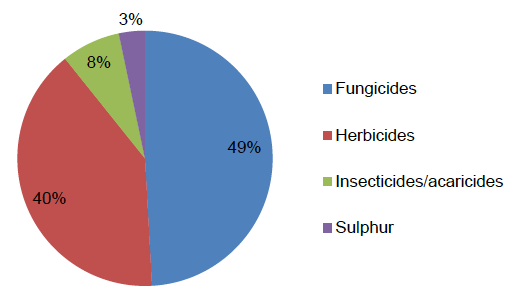
Figure 26: Timings of pesticide applications on non-protected raspberries - 2016
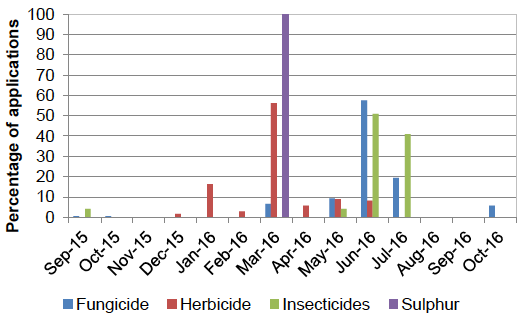
Protected raspberries
- An estimated 199 hectares of protected raspberries were grown in Scotland in 2016. Based on the ratio encountered in the sample, it is estimated that 73 per cent of the crops was semi-protected (grown under temporary tunnels) and 27 per cent permanently protected (grown in permanent tunnels or glasshouses)
- Pesticides were applied to 1,565 treated hectares. Fungicides and insecticides were the most commonly applied pesticides ( Figure 27)
- Almost the entire crop (>99 per cent) received a pesticide treatment
- 877 kilograms of pesticide were applied to the crop
- Glen Ample was the principal variety encountered, accounting for 47 per cent of the sample area
- Protected raspberries received on average 6.6 applications of pesticides ( Table 1). These sprays included 3.9 fungicide, 1.7 insecticide and 1.5 herbicide and biological applications
- The majority of herbicide use was in January and February, whereas fungicide use was spread throughout the season with 42 per cent applied in June. Insecticide use peaked in May and 68 per cent of biologicals were applied in July ( Figure 28)
Summary of pesticide use on protected raspberries:
| Pesticide group | Formulation area treated (ha) | Weight of pesticides applied (kg) | % of crop area treated | Most used formulations (ha) |
|---|---|---|---|---|
| Fungicides | 815 | 505 | 99 | Fenhexamid (189), boscalid/pyraclostrobin (152) |
| Herbicides | 305 | 332 | 67 | Diquat (79), carfentrazone-ethyl (78) |
| Insecticides/acaricides | 370 | 33 | >99 | Abamectin (152) |
| Molluscicides | <0.5 | <0.5 | <0.5 | Ferric phosphate (<0.5) |
| Biopesticides | 72 | 7 | Bacillus subtilis (64) | |
| Biological control agents | 3 | N/A | Phytoseiulus persimilis (3) |
N/A = not applicable
Figure 27: Use of pesticides on protected raspberries (percentage of total area treated with formulations) - 2016
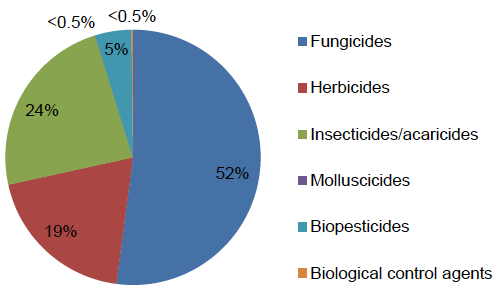
Figure 28: Timings of pesticide applications on protected raspberries - 2016
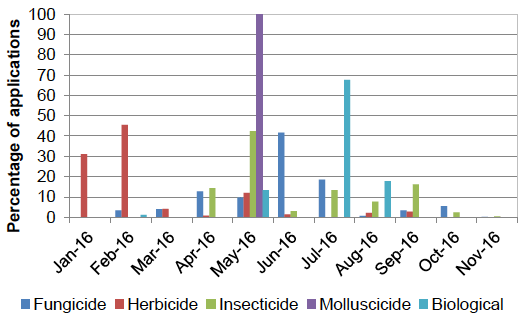
Note: Insecticides include acaricides. Biologicals includes biopesticides and biological control agents
Blackcurrants
- The total estimated area of blackcurrants grown in Scotland in 2016 was 304 hectares. This includes two hectares which were included in the mixed and other soft fruit census category
- Pesticides were applied to 3,372 treated hectares. Fungicides were the most commonly applied pesticides ( Figure 29)
- Almost the entire crop (99 per cent) received a pesticide treatment
- 4,520 kilograms of pesticide were applied to blackcurrant crops (71 per cent of which was sulphur)
- Blackcurrants received on average 8.1 pesticide applications. These spays included 5.3 fungicide, 2.4 insecticide, 1.6 herbicide and 2.0 sulphur applications
- In relation to timings, fungicides were predominately used in May and June. Fifty-nine percent of herbicides were applied in February, 53 per cent of insecticides in June and all sulphur was applied in March and April ( Figure 30)
- Ben Kilbreck was the principal variety encountered, accounting for 30 per cent of the area surveyed
- 47 per cent of blackcurrants encountered were five years old or less, seven per cent were between six and 10 years old and three per cent were older than 11 years old with the remainder unknown
- All of the blackcurrant crops sampled were grown in the soil without protection
- 80 per cent of the blackcurrant crops surveyed were harvested in 2016
- 97 per cent of the blackcurrant crops surveyed were for processing, two per cent was for fresh market and one per cent was for pick-your-own
- Reasons for pesticide use are provided in Figures 31 and 32. General weed control was the only reason given for herbicide use
Summary of pesticide use on blackcurrants
| Pesticide group | Formulation area treated (ha) | Weight of pesticides applied (kg) | % of crop area treated | Most used formulations (ha) |
|---|---|---|---|---|
| Fungicides | 1,459 | 412 | 87 | Myclobutanil (518) |
| Herbicides | 968 | 839 | 91 | Diquat (268), pendimethalin (256) |
| Insecticides/acaricides | 943 | 62 | 92 | Lambda-cyhalothrin (387), thiacloprid (345) |
| Sulphur | 402 | 3,207 | 68 | N/A |
N/A = not applicable
Figure 29: Use of pesticides on blackcurrants (percentage of total area treated with formulations) - 2016

Figure 30: Timings of pesticide applications on blackcurrants - 2016
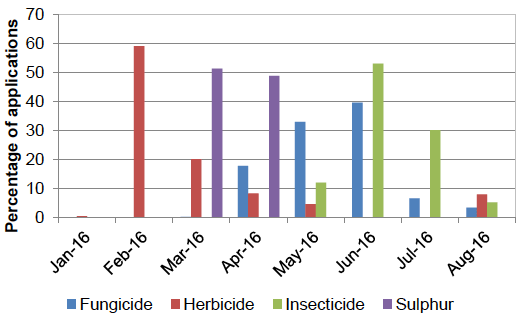
Figure 31: Reasons for use of fungicides on blackcurrant crops (where specified) – 2016
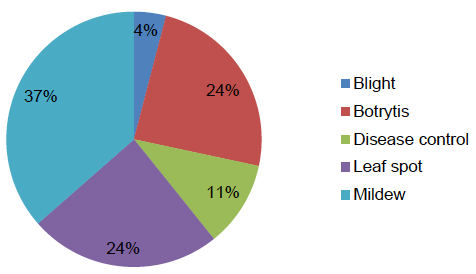
Note: No reasons were provided for blackcurrants grown for processing, therefore reasons only relate to crops grown for the pick your own or fresh market
Figure 32: Reasons for use of insecticides on blackcurrant crops (where specified) – 2016
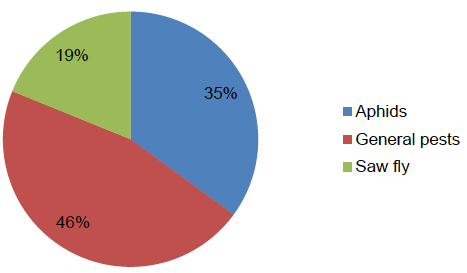
Note: No reasons were provided for blackcurrants grown for processing, therefore reasons only relate to crops grown for the pick your own or fresh market
All other soft fruit crops (protected and non-protected crops)
- An estimated 248 hectares of other soft fruit was grown in 2016. This consists of 68 hectares of non-protected crop and 180 hectares of protected crop
- The crops encountered in this category were blueberry, blackberry, gooseberry and redcurrant as well as minor crops aronia (chokeberry), jostaberry, loganberry, tayberry, tummelberry and whitecurrant
- Pesticides were applied to 1,469 treated hectares, insecticides and fungicides were the most commonly applied pesticides ( Figure 33)
- 84 per cent of the crop was treated with a pesticide
- 618 kilograms of pesticide were applied to the other soft fruit crops
- Other soft fruit crops received on average 5.8 pesticide applications. These sprays included 3.1 fungicide, 2.5 insecticide, 2.9 biological and 1.4 herbicide applications
- Fungicide and insecticides were applied between March and August. Herbicides were predominately applied between January and March and Biological control agents were applied throughout the spring, summer and autumn ( Figure 34)
- 23 per cent of other soft fruits crops sampled were five years old or less, 33 per cent were six to 10 years old, 26 per cent were over 10 years old and the age of 18 per cent of the surveyed crops were unknown
- 80 per cent of the other soft fruit crops surveyed were grown in the soil, with the remainder being grown in pots
- 37 per cent of the crop was grown outdoors, 44 per cent was grown under temporary tunnels and 19 per cent was grown under permanent protection
- 18 per cent of the sampled crop was grown using a ground mulch
- Pollinators were used on 47 per cent of the other soft fruit crops sampled, 30 per cent had no pollinators and the remainder was unknown. Of the sampled area using pollinators, 54 per cent were bumble bees, 18 per cent were honey bees and 28 per cent were both bumble and honey bees
- 88 per cent of the crops surveyed were harvested in 2016 (one per cent was not harvested with the remainder unknown). 96 per cent were for fresh market and one per cent for processing and three per cent for pick-your own
- Reasons for pesticide use are provided in Figures 35 and 36. General weed control was the only reason given for herbicide use. Aphids and vine weevils were the only specified reasons for the use of biological control agents
Summary of pesticide use on all other soft fruits:
| Pesticide group | Formulation area treated (ha) | Weight of pesticides applied (kg) | % of crop area treated | Most used formulations (ha) |
|---|---|---|---|---|
| Fungicides | 414 | 189 | 51 | Cyprodinal/fludioxonil (155) |
| Herbicides | 270 | 354 | 53 | Diquat (107) |
| Insecticides/acaricides | 494 | 42 | 81 | Thiacloprid (268) |
| Molluscicides | 40 | 8 | 9 | Ferric phosphate (40) |
| Sulphur | 6 | 25 | 1 | N/A |
| Biological control agents | 245 | N/A | 34 | Heterorhabditis bacteriophora (136) |
N/A = not applicable
Figure 33: Use of pesticides on all other soft fruit crops (percentage of total area treated with formulations) - 2016
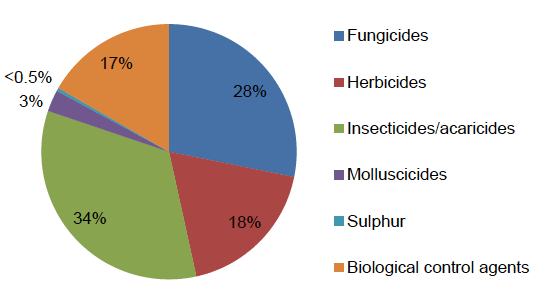
Figure 34: Timings of pesticide applications on all other soft fruit crops - 2016
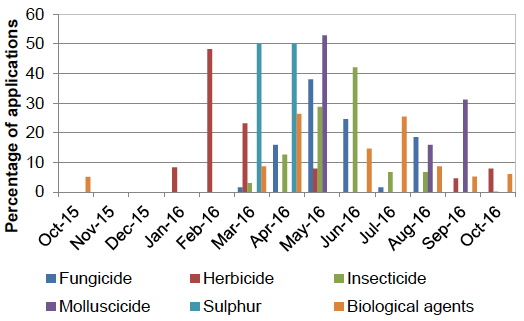
Note: Insecticides include acaricides
Figure 35: Reasons for use of fungicides on all other soft fruit crops (where specified) – 2016
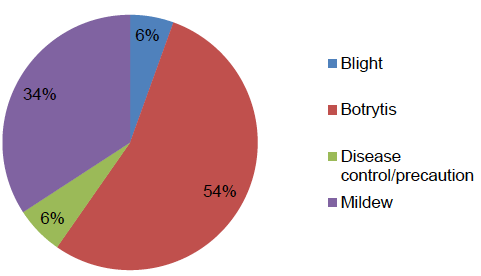
Figure 36: Reasons for use of insecticides on all other soft fruit crops (where specified) – 2016
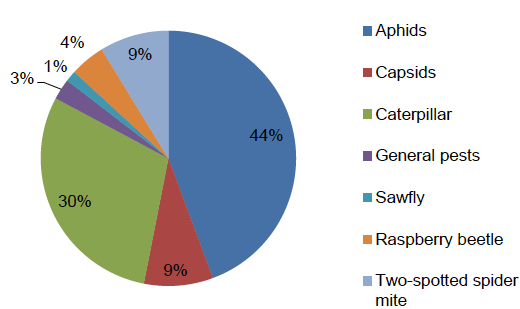
Non-protected other soft fruit crops
- The total estimated area of non-protected other soft fruit crops is 68 hectares. An estimated 27 hectares recorded in the non-protected census category were temporarily covered with Spanish tunnels. Estimated pesticide use on these crops have been included with the protected other soft fruit crop
- The crops encountered in this category were blueberry, blackberry, gooseberry and redcurrant as well as the minor crops aronia (chokeberry), jostaberry, loganberry, tayberry, tummelberry and whitecurrant
- Pesticides were applied to 228 treated hectares. Fungicides and herbicides were the most commonly applied pesticides ( Figure 37)
- 41 per cent of non-protected other crops were treated with a pesticide
- 124 kilograms of pesticide were applied
- Non-protected other soft fruit crops received on average 4.9 pesticide applications. These sprays included 3.9 fungicide, 1.6 herbicide and 1.4 insecticide applications
- Herbicides were all applied in the first three months of the year. Fungicides were applied between March and August and insecticides between May and August ( Figure 38)
Summary of pesticide use on non-protected other soft fruits:
| Pesticide group | Formulation area treated (ha) | Weight of pesticides applied (kg) | % of crop area treated | Most used formulations (ha) |
|---|---|---|---|---|
| Fungicides | 125 | 41 | 37 | Myclobutanil (26) |
| Herbicides | 72 | 72 | 36 | Diquat (22) |
| Insecticides/acaricides | 29 | 2 | 31 | Deltamethrin (13), Thiacloprid (11) |
| Sulphur | 2 | 9 | 2 | N/A |
N/A = not applicable
Figure 37: Use of pesticides on non-protected other soft fruit crops (percentage of total area treated with formulations) - 2016
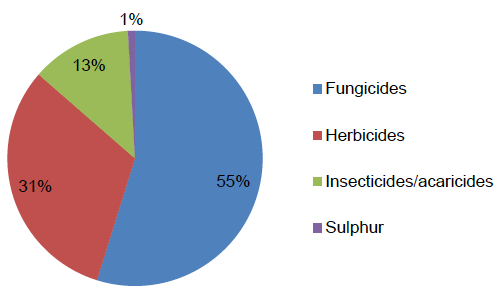
Figure 38: Timings of pesticide applications on non-protected other soft fruit crops - 2016
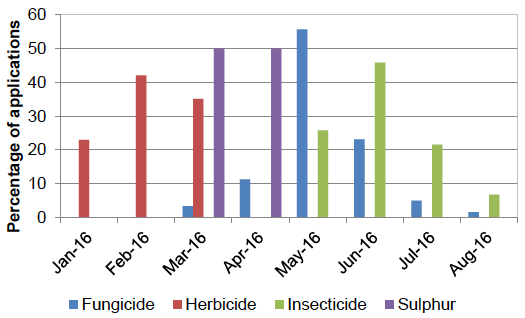
Note: Insecticides include acaricides
Protected other soft fruit crops
- The total estimated area of protected other soft fruit crops in 2016 is 180 hectares. It is estimated that 65 per cent of the crop was semi-protected grown under temporary tunnels with 35 per cent grown under permanent tunnels or glasshouses
- The crops encountered in this category were blueberry and blackberry
- Pesticides were applied to 1,240 treated hectares. Insecticides/acaricides and fungicides were the most commonly applied pesticides ( Figure 39)
- The entire crop area was treated with a pesticide
- 494 kilograms of pesticide were applied
- Protected crops received on average 6.0 pesticide applications. These sprays included 2.9 fungicide and biological, 2.6 insecticide, 1.9 molluscicide and 1.3 herbicide applications
- Fungicide and insecticides were applied between March and August. Herbicides were predominately applied between January and March and Biological control agents were applied throughout the spring, summer and autumn ( Figure 40)
Summary of pesticide use on non-protected other soft fruits:
| Pesticide group | Formulation area treated (ha) | Weight of pesticides applied (kg) | % of crop area treated | Most used formulations (ha) |
|---|---|---|---|---|
| Fungicides | 289 | 150 | 56 | Cyprodinal/fludioxonil (151) |
| Herbicides | 197 | 281 | 59 | Diquat (85) |
| Insecticides/acaricides | 465 | 40 | >99 | Thiacloprid (257) |
| Molluscicides | 40 | 8 | 12 | Ferric phosphate (40) |
| Sulphur | 4 | 15 | 1 | N/A |
| Biological control agents | 245 | N/A | 46 | Heterorhabditis bacteriophora (136) |
N/A = not applicable
Figure 39: Use of pesticides on protected other soft fruit crops (percentage of total area treated with formulations) - 2016
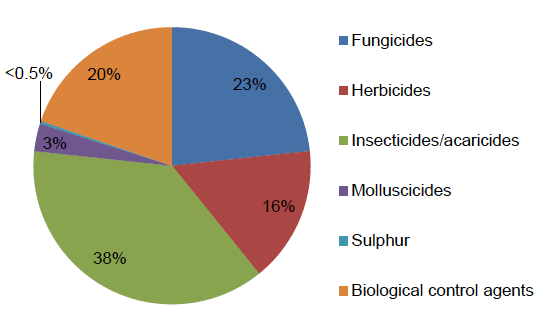
Figure 40: Timings of pesticide applications on protected other soft fruit crops - 2016
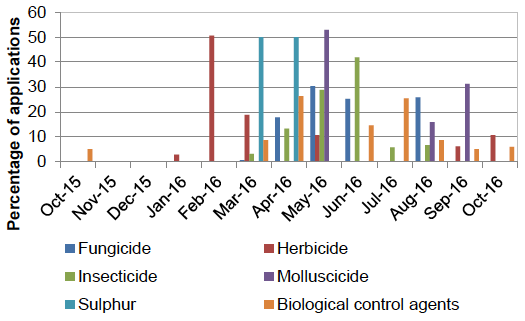
Note: Insecticides include acaricides
Contact
There is a problem
Thanks for your feedback